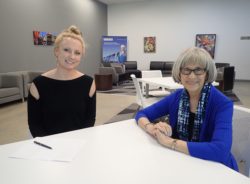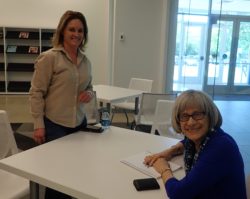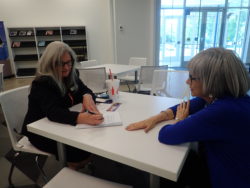In April, I joined the Chattanooga Regional Manufacturers Association (CRMA) Alliance in Manufacturing Excellence (AIME) as Editor-in-Chief of the American Diversity Report. I was invited to be the official communications person by Lulu Copeland, the facilitator and committee chair of CRMA AIME. Copeland is also the founding member of the Society of Women Engineers (SWE) for whom I facilitated an inaugural panel years ago. My assignment at this event marking National Welding Month was to interview women in the welding profession.
Hosted on the campus of Chattanooga State Community College, the roster of participating organizations was impressive. It included the American Welding Society (AWS) Chattanooga, American Society of Quality (ASQ) Chattanooga, Association of Non-Destructive Testing (ASNT), and Chattanooga State’s Institute of Material Joining and Testing (IMJAT).
A series of presentations showcased local companies with welding as the main focus of their operation. Each presentation underscored the need to work together to develop and maximize welding expertise. The presenters discussed the changing context of welding which increasingly requires robotics and computer skills:
- Russel Decker, CWE, Miller Industries
- Randy McCallie, Automation Manager, Tennessee Rand/Lincoln Electric
- James Smith, Quality Manager, Ivey Cooper
Challenges now and for the future
The presenters highlighted the dire need of more skilled tradespeople. According to the national AWS website, there will be a shortage of over 450,000 skilled welding professionals by 2022. “Every day in thousands of shipyards, automotive assembly plants and construction sites, skilled welding professionals are working to build the structures and products on which the American economy depends. These professionals are behind the scenes welding the very backbone of industry and your world.”
Despite the number of jobs available, students and career-changing adults are not aware of the opportunities available in the industry. Therefore, much of the discussion centered on creating that awareness and providing the training needed to develop a cadre of future professionals. The presenters spoke about their changing in-house training programs, tours provided to high schools students, classroom talks and videos, as well as outreach to groups such as the Boy Scouts.
Women and Welding Excellence
With women comprising only 5 % of current professionals, there is much interest in attracting women into the field. Multiple tradeswomen organizations can be found online, providing information, resources, and support. Many of the women attending this April event have been looking closely at how to grow the number of women in the welding trade. Copeland chose three remarkable women for me to interview, each of whom excels in her own way.

1. Alex Hockman
Engineering Sales, Lincoln Electric Company and Vice Chair of AWS Chattanooga
Alex Hockman is Vice Chair of the Chattanooga chapter of the American Welding Society which celebrated its 100th anniversary in April, National Welding Month. The chapter has about 300 members. She began the interview by speaking to the need to attract new, young people to the profession. Alex notes that the average at Welding Electric is fifty-six and much of the move to robotics is to help fill the gap in the labor force pipeline.
Her early interest in science and math, along with her competitive and adventuresome spirit, led her to major in Industrial Engineering at West Virginia University and minor in English. This 2012 graduate combined her engineering education with communication skills and has been an engineering salesperson with The Lincoln Electric Company for 7 years. She is passionate abut her job in which every day is different and she can use both her engineering background and writing skills on everything from e-mails to proposals.
Lincoln Electric is a major player in the welding industry. Therefore, she has the opportunity to travel to various customer sites around the entire state of Tennessee and into Georgia. Despite the appeal of not being stuck behind a desk, Alex notes that only 15% of the engineering sales force is female.
2. Tracie Clifford
Program Lead – NDT & QA/QC, Chattanooga State Community College
Tracie Clifford is from rural Tennessee. Her engineering journey demonstratives that creativity and what it’s like to continually be in the discovery mode. Shew grew up on a farm in Appison that her family has owned for more than a century. Her love of animals led her to the natural sciences and a B.S. in Biology/Chemistry. She applied her education to pharmaceutical manufacturing in California where she was a quality engineer before returning to Tennessee to be with family.
Tracie worked in medical device manufacturing and combined medical and pharmaceutical device implants. She described the complicated path of her work, “Engineers use animals studies, clinical trials and start-ups to progress to privately owned manufactures to publicly traded ones with FDA approval, locally, nationally, and internationally.”
Her life-long interest in learning and exploring new aspects of engineering has led to much travel and her current pursuit of a M.S. degree in Engineering Management. As a college instructor and adjunct member of the advisory and quality program faculty, she mentors both college and high school students. She wants students to understand that every industry, service and product has quality, providing multiple options for quality engineers. Passionate about engaging more women into STEM fields, Tracie has two national Science Foundation grants in process to assist her cause.

3. Dusti Jones
Sr. Welding Engineer, Astec Inc., AWS Chattanooga officer
The third interview with Dusti Jones showed yet another side of women in engineering. Dusti grow in Helper, Utah, where her high school is located near the community college and she was able to attend both concurrently. When faced with the choice of courses to complete her degree, she chose welding over cosmetology and it became a passion. She got welding jobs and won scholarships from the National Welding Society to pay her way through Utah State University studying Welding Engineering Technology.
At this stage in her career, Dusti teaches a course called WeldTec: The Art & Science of Welding. Her colleague, welding specialist Scott Kovacs, teaches the Art, awhile she teaches the Science. The course is designed to update skills and motivate with revelations of how and why. Educating and inspiring is part of Dusti’s role as an officer in the local AWS. She is dedicated to making high school students aware of the possibilities in her profession by giving tours and promoting the scholarships that AWS provides annually.
Dusti explained that her work in construction differs from manufacturing where robotics increasingly fill the skills gap. Construction is hand-eye coordination requiring both practice and learning the technology behind what you’re doing. You need to be an athlete able to work with strange angles and have the ability to think on your feet. Dusti used the power industry as an example. When she goes to retrofit a power plant with new materials to improve efficiency, she must understand the metallurgy to adapt and trouble shoot. The planned outages to do the work don’t provide much time. The cost of downtime can be $16,000 per hour, so there may be only two days to complete all repairs. She must be able assess and oversee her crew, telling them what repairs are to be made what materials are to be used and with what heat and cooling.
Advice for Aspiring Students
Alex’s advice to young women is to not shy away from male-dominated fields. You have the potential to succeed more than men because you are often under-estimated, probably have good people skills, and the industry is looking to establish a diverse workforce.
Tracie’s advice is to look closely at how creative engineering can be. Discover the many options that are available. Try to find people in an industry that appeals to you who will not just let you shadow them, but give you hands-on experience. You will better understand how that specific activity impacts the industry, its workers, and the people who use its services and products. Discover what is out there
Dusti is concerned for the next generation’s participation and notes that many of the scholarships go unused because students do not fill out the paperwork and apply. Dusti hopes that young people will use this link to apply, especially women. https://scholarship.aws.org/applications/. Dusti has been the sole female on most of her jobs and during her education. Knowing the opportunities that are available, she hopes more women will opt for a similar path to her own.
- Inter-generational education needed now – by Deborah Levine - April 19, 2024
- Tracking our Terrorist Destructors – by Deborah Levine - April 19, 2024
- UNTOLD Stories of a World War II Liberator - April 10, 2024



My husband has just graduated from his trade school and will be going to a few interviews later this week. Your information that associations for quality and non-destructive testing were holding the convention for welders was really fascinating. Maybe my husband should start looking into non-destructive testing companies so that he can ensure his quality after getting a job.